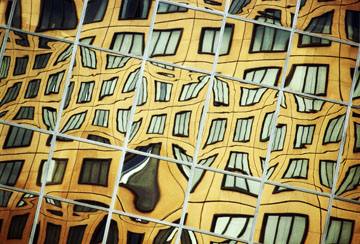Intersecting lines are a useful and potentially powerful addition to photographic compositions. In the simplest cases, actual lines occurring within the subject matter are positioned in the frame in a way that leads the eye to the centre of interest. There are at least vague links between the use of such lines and the principle defined by golden ratio described in another article. However, diagonal lines in images are usually powerful in their own right, and lead to more dynamic and interesting compositions. In landscapes, the lines are usually easy to define but not necessarily easy to locate in an image given other constraints. In areas such as portraiture it is certainly best to avoid straight lines which lead the eye up and down, or horizontally across an image. Diagonals, or at least inclined lines, are almost always more effective although they may be difficult to identify. Don't overlook implied lines such as the line of the gaze of a human subject. When directed down towards a far corner of the frame, these can have the same compositional advantages as actual visible lines.
 When lines intersect, the combination of their individual effects combine to focus the eye in a more powerful manner upon the point of intersection. If a particular subject is located at this intersection, the viewer's eye will be led directly to it. Where lines intersect in the frame, and where they begin and end, also has a significant compositional effect. There is a tendency, at least in much of the world, for viewers' eyes to follow lines from left to right and from top to bottom. This is arguably a result of being trained over a lifetime to follow words written on a page in this same basic directions. A diagonal line that enters the frame from the left-hand side and then flows across the image to the lower right is therefore seen by some photographers as the most natural for the eye to follow. However, in landscape photography, it is common to find the line of a path or fence used to lead the eye from a lower corner of an image to the more central areas. Lines which actually enter an image from beyond the edge of the frame probably have the most powerful influence on composition.
When lines intersect, the combination of their individual effects combine to focus the eye in a more powerful manner upon the point of intersection. If a particular subject is located at this intersection, the viewer's eye will be led directly to it. Where lines intersect in the frame, and where they begin and end, also has a significant compositional effect. There is a tendency, at least in much of the world, for viewers' eyes to follow lines from left to right and from top to bottom. This is arguably a result of being trained over a lifetime to follow words written on a page in this same basic directions. A diagonal line that enters the frame from the left-hand side and then flows across the image to the lower right is therefore seen by some photographers as the most natural for the eye to follow. However, in landscape photography, it is common to find the line of a path or fence used to lead the eye from a lower corner of an image to the more central areas. Lines which actually enter an image from beyond the edge of the frame probably have the most powerful influence on composition.
Abstract images may also often benefit from the use of diagonal or intersecting lines. Take a close-up image of the windows of a modern glass office block, and orientate the camera so that the grid defined by the various windows and storeys divides the frame vertically and horizontally, and the result will probably be dull and uninteresting. Create a similar image with the camera rotated by 30 or 40 degrees, so the dividing lines flow across the frame diagonally, and the image becomes much more dynamic and interesting. If possible find a feature on the side of the building which can be located one third of the way into the frame both horizontally and vertically, such as a particular reflection or a differently coloured object, and the image finally comes alive. The reason for this is that the eye follows the lines to their intersections. If some different or interesting feature is then appropriately located at such an intersection, the image suddenly acquires compositional balance.
In the image on the left, the distorted reflections are interesting in their own right, but also held together in a dynamic diagonal grid. The one different window, which seems to feature a greater degree of curvature and consequently reflect a quite different image, is located approximately one third across and up the image. The result is much more striking than a similar image where the grid lines are almost horizontal and vertical.






